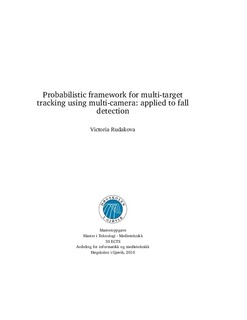| dc.description.abstract | The developments in health care lead to longer life expectancy in developed countries. The growth of the number of seniors put new challenges to health care services, caregivers and family members. One of the major challenges is how to prevent elderly people from falling down. Especially, if the person lives alone, falling can be quite dangerous for his / her health. Falling down can cause serious consequences like broken bones or lost consciousness for elderly people. Therefore, it is of key importance to be able to provide help as soon as possible, or, even try to prevent the incident. Combining video-based surveillance and computer vision techniques could bring us towards intelligent systems that could help to monitor the elderly and raise an alarm in case of unusual and dangerous events. The main question is how to automate fall detection using only video information (like camera network) with application in public health and health services (i.e., elderly houses, hospitals). Generally, when talking about video surveillance systems, there are some elements that would remain the same in every system irrespective of the application. These are: tracking, data association in context of camera network and post-processing based on extracted information (like activity recognition). So, this thesis addresses each of these questions and tries to find a generalized framework that could integrate all the methods in one system.
One of the main criterion of the project was to avoid camera calibration - that is, correspondence between views should be based on some confidence or probability function between camera views. Therefore, it was decided to adopt a Bayesian framework for multi-target multicamera tracking [1] that fulfills our requirements. When considering a single view from one camera, the system allows to represent each target as a set of samples (or particles) that have probabilistic measures (weights) proportional to the likelihood of the target being at that position. For multi-camera system, one needs to associate corresponding targets among camera views. Gale-Shapley algorithm for finding stable matching between two classes (in our case - cameras) was modified for this purpose. For fall detection part, silhouette- and velocity-based set of features were extracted and passed through Support Vector Machine (SVM) to separate fall events from other activities. A set of test videos were recorded using two cameras to test stability of the tracking framework and the reliability of fall detection algorithm. The initial results are encouraging. Further integration of additional features may improve the performance of the system. | en_US |
